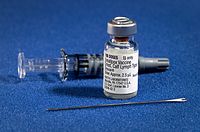
Photo from wikipedia
As maternal passive immunity wanes at 6-8 weeks, young calves must rely on their own naïve and developing immune system for protection against pathogens. Typically, an infection in the young… Click to show full abstract
As maternal passive immunity wanes at 6-8 weeks, young calves must rely on their own naïve and developing immune system for protection against pathogens. Typically, an infection in the young induces a T cell-mediated response, which skews towards a Th2 phenotype and results in a reduced effector response. Our study examines the implications this transitional period of immunocompetency has on cellular metabolism in young calves, focusing on effector function of CD4+ T cells in comparison to those from adult cows. Results from sorted CD4+ T cells from young calves and adult cows activated by α-CD3:α-CD28, show that young calves exhibit a significantly greater propensity to produce the Th2 cytokine, IL-4, in comparison to IFN-γ. Concomitantly, cells from young calves and adult cows exhibit no statistical difference in cell surface marker expression induced by α-CD3:α-CD28 stimulation. Metabolically, activated CD4+ T cells from young calves show significantly greater utilization of mitochondrial respiration, measured by oxygen consumption rate (OCR), and greater glycolytic reserve, measured by extracellular acidification rate (ECAR). However, adult cows have a significantly higher change in glycolytic rate after α-CD3:α-CD28 stimulation compared to young calves. Further, CD4+ T cells from young calves have an increased mRNA expression signature associated with glycolytic metabolism (GAPDH, HK2, FBP1, HIF1A) and Th2-associated metabolic signaling (RPTOR) in comparison to adult cows. The distinct metabolic phenotype and associated gene expression in activated CD4+ T cells may be intrinsic drivers of the Th2-biased response by young calves. Additionally, CD4+ recent thymic emigrant cells (RTEs) may further contribute to altered effector function, as they are preferential precursors to Tregs, and based on the microenvironment, have the propensity to polarize toward Th2. Evaluation of T cell master transcription regulators, as well as measuring signal joint T cell receptor excision circles between young calves and adult cows, we observed a significantly increased proportion of RTEs from sorted CD4+ T cells. In this study, we show a unique metabolic profile exhibited by activated CD4+ T cells from young calves in which mitochondrial respiration and glycolytic capacity is significantly increased compared to adult cows.
Journal Title: Veterinary immunology and immunopathology
Year Published: 2022
Link to full text (if available)
Share on Social Media: Sign Up to like & get
recommendations!